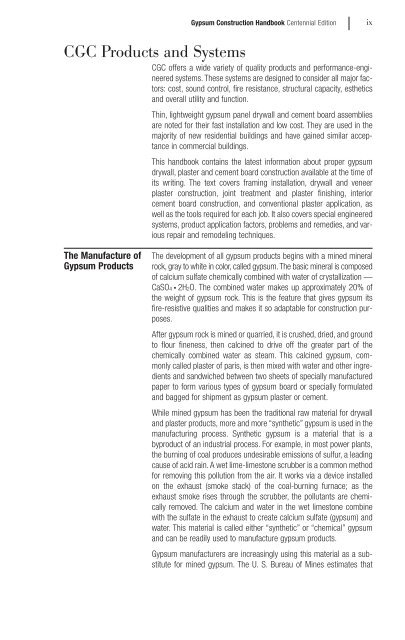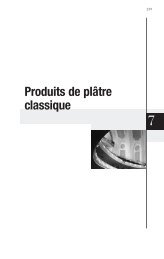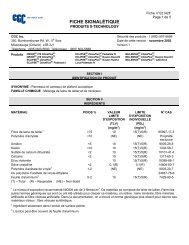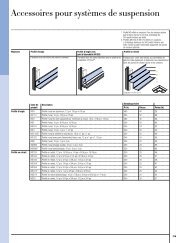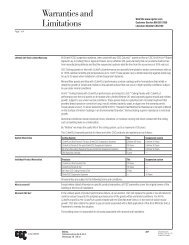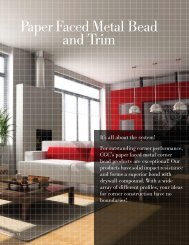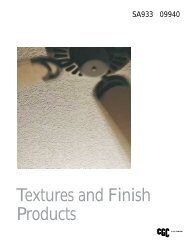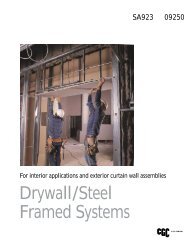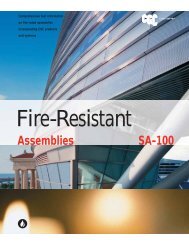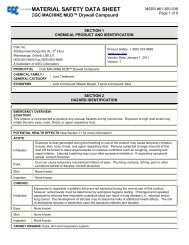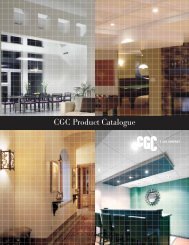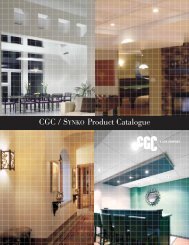The Gypsum Construction Handbook - CGC
The Gypsum Construction Handbook - CGC
The Gypsum Construction Handbook - CGC
You also want an ePaper? Increase the reach of your titles
YUMPU automatically turns print PDFs into web optimized ePapers that Google loves.
<strong>Gypsum</strong> <strong>Construction</strong> <strong>Handbook</strong> Centennial Edition<br />
<strong>CGC</strong> Products and Systems<br />
<strong>CGC</strong> offers a wide variety of quality products and performance-engineered<br />
systems. <strong>The</strong>se systems are designed to consider all major factors:<br />
cost, sound control, fire resistance, structural capacity, esthetics<br />
and overall utility and function.<br />
Thin, lightweight gypsum panel drywall and cement board assemblies<br />
are noted for their fast installation and low cost. <strong>The</strong>y are used in the<br />
majority of new residential buildings and have gained similar acceptance<br />
in commercial buildings.<br />
This handbook contains the latest information about proper gypsum<br />
drywall, plaster and cement board construction available at the time of<br />
its writing. <strong>The</strong> text covers framing installation, drywall and veneer<br />
plaster construction, joint treatment and plaster finishing, interior<br />
cement board construction, and conventional plaster application, as<br />
well as the tools required for each job. It also covers special engineered<br />
systems, product application factors, problems and remedies, and various<br />
repair and remodeling techniques.<br />
<strong>The</strong> Manufacture of <strong>The</strong> development of all gypsum products begins with a mined mineral<br />
<strong>Gypsum</strong> Products rock, gray to white in color, called gypsum.<strong>The</strong> basic mineral is composed<br />
of calcium sulfate chemically combined with water of crystallization —<br />
CaSO4 • 2H2O. <strong>The</strong> combined water makes up approximately 20% of<br />
the weight of gypsum rock. This is the feature that gives gypsum its<br />
fire-resistive qualities and makes it so adaptable for construction purposes.<br />
After gypsum rock is mined or quarried, it is crushed, dried, and ground<br />
to flour fineness, then calcined to drive off the greater part of the<br />
chemically combined water as steam. This calcined gypsum, commonly<br />
called plaster of paris, is then mixed with water and other ingredients<br />
and sandwiched between two sheets of specially manufactured<br />
paper to form various types of gypsum board or specially formulated<br />
and bagged for shipment as gypsum plaster or cement.<br />
While mined gypsum has been the traditional raw material for drywall<br />
and plaster products, more and more “synthetic” gypsum is used in the<br />
manufacturing process. Synthetic gypsum is a material that is a<br />
byproduct of an industrial process. For example, in most power plants,<br />
the burning of coal produces undesirable emissions of sulfur, a leading<br />
cause of acid rain. A wet lime-limestone scrubber is a common method<br />
for removing this pollution from the air. It works via a device installed<br />
on the exhaust (smoke stack) of the coal-burning furnace; as the<br />
exhaust smoke rises through the scrubber, the pollutants are chemically<br />
removed. <strong>The</strong> calcium and water in the wet limestone combine<br />
with the sulfate in the exhaust to create calcium sulfate (gypsum) and<br />
water. This material is called either “synthetic” or “chemical” gypsum<br />
and can be readily used to manufacture gypsum products.<br />
<strong>Gypsum</strong> manufacturers are increasingly using this material as a substitute<br />
for mined gypsum. <strong>The</strong> U. S. Bureau of Mines estimates that<br />
ix


